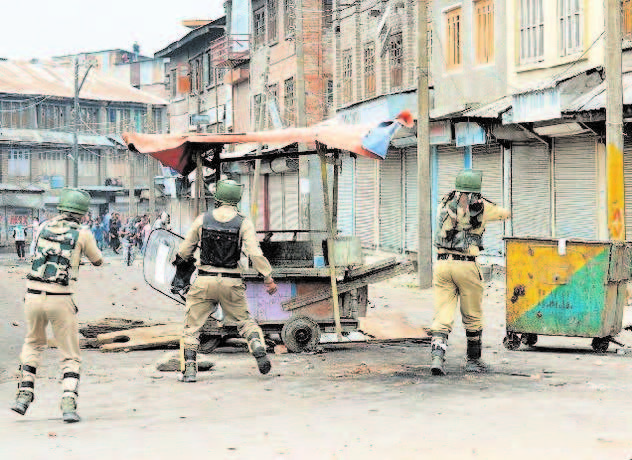
A 21-year-old Kashmiri militant commander, Burhan Wani, was killed by security forces on Friday, July 8. The immediate reaction to Burhan’s killing was an immense outpouring of grief, which then morphed into protests. These protests generated a violent response by the state. The cumulative death toll accruing from this structural cycle of violence is 38 as I write; 1,500 people stand injured in the melee of violence.
Policy of containment
As Kashmir burns, to so speak, and consumes itself in an orgy of violence and counter-violence by the state, Delhi appears to be nonchalant or even in denial mode. A high-level meeting, for instance, chaired by Prime Minister Narendra Modi did not have any shade of the political spectrum of Kashmir on board. This bizarre state of affairs suggests that Delhi is too sure of itself on how to “deal” with Kashmir. It views the recurrent and recurring patterns of violence as a “management problem” or is cynical. This cynicism is perhaps fed by Delhi’s assessment that the current phase of violence that has Kashmir in a vice-like grip will fade and fizzle out.
These two assumptions of Delhi betray a short-term policy horizon and total lack of understanding of the conflict and the violence it begets. And what informs these assumptions appears to be that containing the conflict through might and power and managing its other dimensions will be the antidote to the Kashmir problem. But these approaches are flawed – as the modern history of Kashmir suggests.
Historically, Delhi’s policy of intrigue and coercive manipulations of Kashmir’s politics was one major factor for generating armed insurrection here. However, while from a counterinsurgency standpoint, the intensity and momentum of militancy in Kashmir dissipated, the underlying reality remained the same.
This underlying reality of Kashmir is neither a legal issue nor a military one; it is a supremely political one, but Delhi, judging from both its past and contemporary practice, does not believe so. If it viewed Kashmir as a political issue defined by multilayered complexity, Delhi would have not reflexively assumed the default option it has taken recourse to: containment and management of the conflict.
Grist to the militancy mill
Essentially, the reaction that Burhan’s death has bred and the chaos that has descended upon Kashmir is not only a response to his death. It is profounder and pertains to the dead end that the politics of the State has reached after years of dilly-dallying by Delhi vis-à-vis Kashmir. A layer of poignancy is added to the condition that obtains in Kashmir due to the political alignments in the State after the 2014 election. The reference here is to the Bharatiya Janata Party-Peoples Democratic Party coalition which, in hindsight, appears to have rubbed Kashmiris the wrong way. Burhan’s killing, in this sense, was the straw that broke the camel’s back. That is, Burhan’s killing catalyzed the cumulative hurt and grievance of Kashmiris.
While the protests, given that they have a shelf life and cannot realistically be sustained, will fizzle out, this need not mean a vindication of Delhi’s policies (or even non-policies) and approach. The protests will provide grist to the mill of militancy in Kashmir. Burhan, in death, has become an icon and an inspiration for the youth of Kashmir. His footsteps are likely to be followed by many Kashmiri youth -educated and ideologically more convinced and resistant to blandishments and even pressure. If no prudent policies vis-à-vis Kashmir are employed, this youth bulge will only grow and the State of Jammu and Kashmir might be once again in the throes of deep and widespread insurgency. The onus for this will fall on the powers that be and their flawed, ill-conceived policies towards Kashmir.
At this point in time, a salvage job is in order. It lies in a comprehensive redesign of policy towards Kashmir – the kind that is non-zero-sum and incorporates all stakeholders in the process of building peace and resolving the conflict in Kashmir. Unless and until this paradigm is instituted, Kashmir, as the reaction generated by Burhan’s killing shows, will always be a cauldron. It is about time that past policies and assumptions are jettisoned and a new approach towards Kashmir crafted. Putting this off for later might leave it a little too late.
The author, Tanvir Sadiq, is a former spokesperson of the Jammu and Kashmir National Conference party, is political secretary to former Chief Minister Omar Abdullah.
The views expressed here are personal.






Be the first to comment